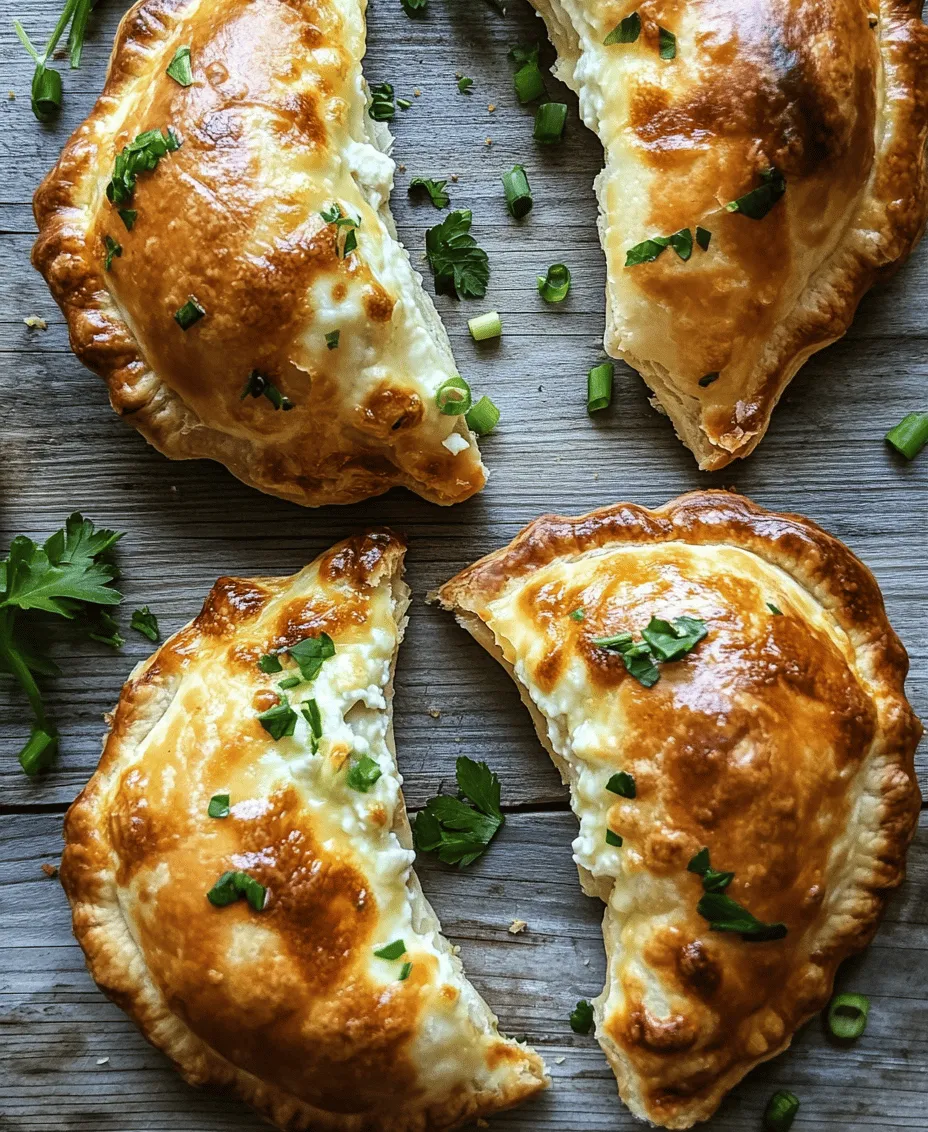Introduction
If you’re looking for a delightful and comforting pastry that warms the soul, look no further than Fatayer. Originating from the rich culinary traditions of the Middle East, this pastry has captivated taste buds for centuries. Traditionally filled with various ingredients, Fatayer can be savory or sweet, but today we’re focusing on a beloved variation—the Cheesy Delight Fatayer. This indulgent dish combines a flaky, golden pastry with a luscious blend of cheeses and aromatic herbs, making it the perfect treat for any occasion.
The appeal of homemade pastries lies not only in their taste but also in the satisfaction of creating something delicious from scratch. Whether you’re hosting a family gathering, preparing a snack for a casual get-together, or simply indulging in a comforting meal at home, Cheesy Delight Fatayer is versatile enough to fit any setting. As you embark on this culinary adventure, you’ll discover the joy of filling your kitchen with the enticing aromas of freshly baked pastries, and the smiles that come with each bite.
Understanding Fatayer
Definition and History of Fatayer
Fatayer is a type of pastry that has deep roots in Middle Eastern cuisine, especially in countries like Lebanon, Syria, and Palestine. The word “Fatayer” itself refers to pastries that are typically filled, folded, and baked until golden. Historically, Fatayer has been prepared during special occasions, family gatherings, and festive celebrations, showcasing the hospitality and culinary artistry of the region.
The dough used for Fatayer is often made with simple ingredients such as flour, water, yeast, and olive oil, resulting in a versatile base that can be filled with a variety of ingredients. Over time, the popularity of Fatayer has spread beyond its origins, inspiring culinary enthusiasts worldwide to experiment with various fillings and flavors.
Variations of Fatayer and Common Fillings
One of the most appealing aspects of Fatayer is its adaptability. While the Cheesy Delight Fatayer focuses on cheese as the main filling, traditional variations may include spinach, meat, or a combination of both. Each region has its own preferred fillings, often influenced by local ingredients and flavors.
For instance, in Lebanon, you might find Fatayer filled with a mixture of spinach and pine nuts, while in Palestine, meat-filled Fatayer seasoned with spices is popular. The possibilities are endless, allowing cooks to personalize their Fatayer to suit their tastes or dietary preferences.
The Cultural Significance of Fatayer
In many Middle Eastern cultures, Fatayer holds a special place at gatherings and celebrations. They symbolize warmth and sharing, often served as appetizers or snacks for guests. The act of making Fatayer can be a communal experience, bringing families and friends together in the kitchen. From rolling out the dough to filling and shaping each pastry, it fosters bonds and creates cherished memories.
The Cheesy Delight Fatayer, with its rich flavors and comforting nature, encapsulates this spirit of togetherness. It invites you to gather around the table, savoring the delicious result of your efforts and sharing stories with loved ones.
Ingredients Breakdown
Creating the perfect Cheesy Delight Fatayer begins with understanding the ingredients that make it so scrumptious.
Overview of the Dough Ingredients
The dough for Fatayer is foundational to the pastry’s success. A few simple ingredients come together to create a tender and flaky pastry that encases the delicious filling. Here’s what you’ll need:
– All-Purpose Flour: This versatile flour provides the structure and texture for the dough. It allows for easy handling and results in a light yet sturdy pastry.
– Yeast: Active dry yeast or instant yeast will help the dough rise, creating a soft and airy texture. Proper activation of yeast is crucial for achieving the right consistency.
– Olive Oil: This ingredient adds flavor and richness to the dough while contributing to its tenderness. Olive oil also aids in the browning process during baking, giving the Fatayer a beautiful golden color.
– Warm Water: Used to activate the yeast and bring the dough together, warm water should be at a temperature that encourages yeast growth without killing it.
Importance of All-Purpose Flour, Yeast, and Olive Oil
The balance of these ingredients is vital. All-purpose flour serves as the backbone of the dough, while yeast provides the necessary leavening to create a light texture. Olive oil not only enriches the flavor but also helps to keep the dough moist and pliable, making it easier to work with.
Detailed Description of the Filling Ingredients
Now, let’s turn our attention to the star of the show: the cheese filling. The choice of cheese is paramount in achieving that cheesy delight.
– Feta Cheese: This tangy and crumbly cheese adds a wonderful flavor and creamy texture to the filling. Feta is a staple in many Middle Eastern dishes and perfectly complements the other ingredients.
– Mozzarella Cheese: Known for its melt-in-your-mouth quality, mozzarella provides that gooey, stretchy texture that you crave in a cheese-filled pastry.
– Ricotta Cheese: This creamy cheese adds a rich depth to the filling. Its mild flavor balances the saltiness of feta, creating a harmonious blend.
Types of Cheese Used and Their Flavor Profiles
Combining different types of cheese allows for a more complex and satisfying flavor profile. Feta brings a distinct tang, while mozzarella offers a mild creaminess, and ricotta adds richness. This combination results in a filling that is not only delicious but also texturally interesting—each bite revealing a different aspect of the cheese.
Role of Fresh Herbs and Spices in Enhancing the Filling
To elevate the flavors of the cheese filling, fresh herbs and spices play a crucial role. Common additions include:
– Fresh Parsley: Chopped parsley adds brightness and a touch of freshness that cuts through the richness of the cheese.
– Mint: This herb brings a refreshing note that complements the other flavors, making each bite feel light and aromatic.
– Black Pepper: A sprinkle of freshly ground black pepper enhances the overall flavor without overpowering the filling.
Preparing the Dough
Now that we’ve covered the ingredients, let’s delve into the step-by-step process of preparing the dough for Cheesy Delight Fatayer.
Step-by-Step Instructions for Dough Preparation
1. Activate the Yeast: Start by combining your warm water (about 110°F) with the yeast in a small bowl. Allow it to sit for about 5-10 minutes until it becomes frothy. This step ensures that your yeast is active and ready to leaven the dough.
2. Mix Dry Ingredients: In a large mixing bowl, whisk together the all-purpose flour and a pinch of salt. This ensures even distribution of salt throughout the dough.
3. Combine Wet and Dry Ingredients: Make a well in the center of the flour mixture and pour in the activated yeast mixture along with the olive oil. Using a wooden spoon or your hands, gradually mix the ingredients until a shaggy dough starts to form.
4. Knead the Dough: Transfer the dough to a lightly floured surface and knead it for about 8-10 minutes. The goal is to develop the gluten, which will give the dough its structure. You’re looking for a smooth and elastic texture; if it feels sticky, sprinkle a bit more flour as needed.
5. First Rise: Place the kneaded dough in a lightly greased bowl, cover it with a damp cloth or plastic wrap, and let it rise in a warm environment for about 1-2 hours or until it has doubled in size.
Importance of Yeast Activation and How to Achieve the Right Dough Texture
Activating the yeast is crucial for a successful rise. If the yeast does not foam up, it may be inactive, and your dough won’t rise properly. The right dough texture should be slightly tacky but not sticky. Adjusting the flour and water ratio while kneading can help achieve this balance.
Tips for Kneading and Rising the Dough Effectively
– Knead with Purpose: Ensure you’re kneading the dough firmly but gently; this process helps develop gluten, which is essential for elasticity.
– Warm Environment: If your kitchen is cool, consider placing the dough in an oven (turned off) with the light on to create a warm environment for rising.
– Patience is Key: Allowing the dough to rise fully will result in a lighter pastry. Don’t rush this process; the longer the dough rises, the better the flavor and texture.
Creating the Filling
With the dough rising, it’s time to prepare the cheesy filling that will make your Fatayer irresistible.
Guide on How to Prepare the Cheese Filling
1. Combine the Cheeses: In a mixing bowl, crumble the feta cheese and add the mozzarella and ricotta. Use a fork or your hands to blend them together until well combined.
2. Add Herbs and Spices: Stir in the chopped parsley and mint, followed by a few grinds of black pepper. Taste the filling and adjust the seasoning as needed.
3. Chill the Filling: For easier handling, consider chilling the filling in the refrigerator for about 30 minutes while the dough finishes rising. This will firm up the mixture, making it easier to portion and shape into the Fatayer.
Emphasis on Ingredient Ratios for Optimal Flavor
The key to a delicious filling lies in the right balance of flavors. Too much feta can overpower the other cheeses, while too little can result in a bland filling. Aim for a ratio that highlights the unique characteristics of each cheese, allowing them to complement rather than compete with one another.
Suggestions for Alternative Fillings or Additional Ingredients
While the classic cheese filling is delightful, feel free to get creative! You can incorporate other ingredients such as:
– Sautéed Spinach: Adds a nutritious element and pairs wonderfully with the cheeses.
– Caramelized Onions: Introduce sweetness and depth to the filling.
– Spices: Consider adding a pinch of za’atar or sumac for a Middle Eastern twist.
By becoming familiar with the fundamental components of Cheesy Delight Fatayer and the techniques involved in making the dough and filling, you’re well on your way to creating a delicious and comforting pastry that will impress family and friends. In the next part of this article, we’ll delve into the shaping, baking, and serving of these delightful pastries. Stay tuned to master the art of Fatayer making!

Shaping the Fatayer
Once your dough has risen beautifully, it’s time to shape your Cheesy Delight Fatayer. Begin by dividing the dough into smaller, manageable portions. A good size for each piece is about the size of a golf ball. This will yield approximately 12-15 Fatayer, depending on how large you wish to make them.
Dividing and Rolling the Dough
Using a sharp knife or a dough cutter, slice the dough into equal pieces. Lightly flour your work surface to prevent sticking. Take one piece of dough and use your hands to gently flatten it into a disc shape. With a rolling pin, roll the dough into a circle about 5-6 inches in diameter. Aim for an even thickness to ensure uniform baking.
Shaping into Half-Moon Forms
Once you have your circle, it’s time to fill it. Place about a tablespoon of your cheesy filling in the center of the dough circle. Be careful not to overfill, as this can make sealing the Fatayer difficult.
To create the iconic half-moon shape, fold the dough in half over the filling, forming a semi-circular shape. Pinch the edges together firmly to seal. For an added decorative touch, you can crimp the edges using your fingers or a fork, which will also help to ensure the filling stays inside during baking.
Presentation Techniques
When arranging your shaped Fatayer on a baking sheet lined with parchment paper, consider spacing them out to allow for expansion and even cooking. You can brush the tops with a bit of olive oil or melted butter for a shiny finish. For a more appealing look, sprinkle sesame seeds or nigella seeds on top before baking.
Baking the Fatayer
Preheat your oven to 400°F (200°C). Preheating is crucial, as it ensures that the Fatayer bake evenly and achieve that perfect golden color. While your oven heats up, prepare your baking sheets with parchment paper to prevent sticking and make cleanup easier.
When the oven is ready, arrange your Fatayer on the sheets. Leave enough space between each piece to allow for puffing and expansion during baking.
Achieving the Perfect Golden Finish
For a beautifully golden finish, consider applying an egg wash. To do this, beat one egg with a tablespoon of water or milk, and brush the mixture lightly over the tops of each Fatayer. This step not only enhances the color but also adds a subtle richness to the crust.
Bake the Fatayer for about 20-25 minutes or until they are golden brown and cooked through. You can check for doneness by gently lifting one Fatayer; the bottom should be slightly firm to the touch and have a nice color.
Serving Suggestions
Once your Cheesy Delight Fatayer are out of the oven, let them cool slightly before serving. They are best enjoyed warm, but they can also be served at room temperature, making them a perfect option for gatherings or as a snack.
For serving, consider pairing your Fatayer with a variety of dips. A refreshing yogurt sauce made with garlic and mint or a zesty tahini sauce complements the cheesy filling beautifully. A simple salad of mixed greens drizzled with olive oil and lemon juice can add a light contrast as well.
Imagine presenting your Fatayer on a beautiful platter, garnished with fresh herbs like parsley or cilantro. The warm, golden pastries will not only be a feast for the palate but also a visual delight for your guests.
Storage and Reheating Tips
If you have any leftovers (which is unlikely, given how delicious they are), it’s important to store them correctly to maintain their freshness. Allow the Fatayer to cool completely before transferring them to an airtight container. You can keep them in the refrigerator for up to three days or freeze them for longer storage.
To freeze, lay the cooled Fatayer in a single layer on a baking sheet and place them in the freezer. Once frozen, transfer them to a freezer bag or container. This method prevents them from sticking together.
When you’re ready to enjoy the leftover Fatayer, reheat them in the oven for the best texture. Preheat your oven to 350°F (175°C), place the Fatayer on a baking sheet, and heat for about 10-15 minutes. If you prefer, a microwave can also be used, but be cautious as it can make the pastry soft rather than crispy.
Healthier Alternatives
While Cheesy Delight Fatayer are undeniably delicious, you can make them a bit healthier without sacrificing flavor. Consider using whole grain flour instead of all-purpose flour for the dough. This not only adds fiber but also provides a nuttier flavor.
For the filling, you can use reduced-fat cheese to cut down on calories. Additionally, incorporating vegetables like spinach, mushrooms, or bell peppers into the cheese mixture can enhance the nutritional profile while adding extra flavor and texture.
These changes not only make the Fatayer lighter but also increase their nutritional value, making them a great option for those looking to enjoy a healthier indulgence.
Conclusion
Making Cheesy Delight Fatayer is a rewarding culinary experience that combines the joy of cooking with the pleasure of sharing delicious food with loved ones. The process, from kneading the dough to shaping and baking, is a wonderful way to connect with the ingredients and create something special.
As you try this recipe, don’t hesitate to personalize it with your favorite fillings or spices. The beauty of this dish lies in its versatility, allowing you to experiment and adapt it to your taste preferences. Homemade culinary creations, like these Fatayer, have the power to bring people together, fostering connections and creating lasting memories around the dining table.
So gather your ingredients, roll up your sleeves, and let the delightful aromas of baking fill your kitchen. Enjoy the process, the flavors, and the smiles that come with sharing your Cheesy Delight Fatayer with family and friends.



